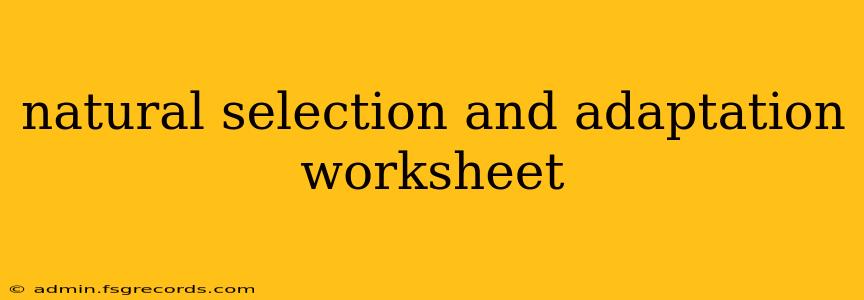This worksheet goes beyond basic definitions, exploring the nuances of natural selection and adaptation with engaging activities and thought-provoking questions. Whether you're a student, teacher, or simply curious about evolutionary biology, this resource will help solidify your understanding of these fundamental concepts.
What is Natural Selection?
Natural selection isn't just "survival of the fittest"—it's a complex process with specific components. Let's break it down:
1. Variation: Individuals within a population show differences in their traits. These variations can be physical (size, color, etc.), behavioral (mating rituals, foraging strategies), or physiological (disease resistance, metabolic rate).
2. Inheritance: Many of these traits are heritable, meaning they are passed from parents to offspring through genes.
3. Overproduction: Populations tend to produce more offspring than can possibly survive in a given environment. This leads to competition for limited resources.
4. Differential Survival and Reproduction: Individuals with traits better suited to their environment are more likely to survive and reproduce, passing those advantageous traits to their offspring. This is where the "fitness" aspect comes in – it's about reproductive success, not necessarily physical strength.
Activity 1: Identifying Variation
Think of a species you're familiar with (e.g., dogs, birds, plants). List at least three variations within that species. For each variation, consider whether it's likely heritable.
| Variation | Heritable? (Yes/No) |
|---|---|
What is Adaptation?
An adaptation is a trait that enhances an organism's survival and reproduction in its specific environment. It's the outcome of natural selection. Adaptations can be structural (physical features), physiological (internal processes), or behavioral (actions or responses).
Activity 2: Adaptation Analysis
Consider the following adaptations. Identify the environmental pressure that likely drove the evolution of each adaptation, and explain how the adaptation increases survival or reproductive success.
| Adaptation | Environmental Pressure | How it Increases Survival/Reproduction |
|---|---|---|
| Camouflage (e.g., a stick insect) | ||
| Long neck (e.g., a giraffe) | ||
| Thick fur (e.g., an arctic fox) |
Misconceptions about Natural Selection
It's crucial to dispel common misunderstandings:
- Natural selection is not random: While variation arises through random mutations, the selection process itself is non-random. Beneficial traits are favored, leading to predictable outcomes.
- Natural selection doesn't create perfect organisms: Adaptations are compromises. A trait that's advantageous in one context might be disadvantageous in another. Environments are also constantly changing.
- Natural selection acts on individuals, but its consequences are seen in populations: Individual organisms don't evolve; populations do. The change in the frequency of advantageous traits within a population over time constitutes evolution.
Further Exploration
- Research a specific example of natural selection: Choose a case study (e.g., the evolution of antibiotic resistance in bacteria, peppered moth evolution) and detail the process of adaptation.
- Discuss the role of genetic drift and gene flow in evolution: How do these factors interact with natural selection?
- Consider the ethical implications of understanding natural selection: How can this knowledge inform our approaches to conservation, medicine, and agriculture?
This worksheet provides a framework for a deeper understanding of natural selection and adaptation. By engaging with the activities and exploring further, you'll gain a more nuanced appreciation of this cornerstone of evolutionary biology.

